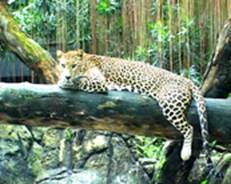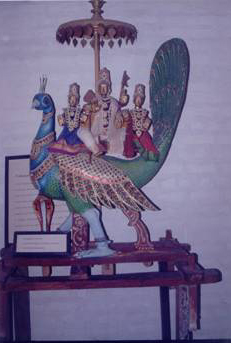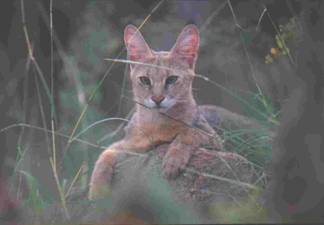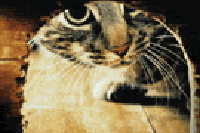Adventure
 'I believe any trip in search of wildlife can be coupled with physical activity and elements of cultural diversity to form a thrilling opportunity ' 'I believe any trip in search of wildlife can be coupled with physical activity and elements of cultural diversity to form a thrilling opportunity '
John H.Eickert |
When I was a boy, sometimes our home could be without power. Snow, rain, wind, ice, and just steady high heat could knock out electricity for days or even weeks. One winter a large storm hit us sending ice and snow. Power lines snapped.
I would lie in bed at night snuggled under thick quilts pretending to use a flashlight to read. Rather than giving attention to school studies, I quickly abandoned my homework and read from wildlife adventures in Africa and India . I clearly recall reading
over and over the story of Jim Corbett, ‘Carpet Sahib,' and the Panna leopard. Nestled under those cozy quilts it was fun to imagine steaming jungle and raw wildlife adventure. The Panna leopard is credited with a record number of human fatalities in both
Nepal and India , that leopard not only being a danger to humanity but a magnificent traveler. A tale of patient waiting at night, death itself to come stalking, is more than enough to warm any young boy.
 I finally had a chance to visit Panna National Park , not sure if this was the same area the famous leopard hunted. I chose the southern route through Madhya Pradesh, ending up staying in a tent on the banks above the Ken River .
I was informed I would not be allowed into the park. Oh, well. Sitting high in a unique tree house restaurant sipping beer, I met a Swiss couple. They informed me they waited a week to get into the park, but did not see a single animal. Their next plan was
to see the diamond mine. I then learned that the largest diamond mine in India was right there next to the park. I spent two more days there, dividing my time between swimming in the river and sipping beer up in the tree house restaurant. When night crept
up around my tent I would think back to my youth and leopards stalking in the night. I am happy to say that time did not dilute those memories and feelings; India is still the land full of promise and adventure. Not all the diamonds of India are embedded in
dark grey Kimberlite rock. The magic of India 's wildlife is it's own rare gemstone. How many carat's in a leopard? How sad if there were no nature stories for small children to read snuggled warm late at night? I finally had a chance to visit Panna National Park , not sure if this was the same area the famous leopard hunted. I chose the southern route through Madhya Pradesh, ending up staying in a tent on the banks above the Ken River .
I was informed I would not be allowed into the park. Oh, well. Sitting high in a unique tree house restaurant sipping beer, I met a Swiss couple. They informed me they waited a week to get into the park, but did not see a single animal. Their next plan was
to see the diamond mine. I then learned that the largest diamond mine in India was right there next to the park. I spent two more days there, dividing my time between swimming in the river and sipping beer up in the tree house restaurant. When night crept
up around my tent I would think back to my youth and leopards stalking in the night. I am happy to say that time did not dilute those memories and feelings; India is still the land full of promise and adventure. Not all the diamonds of India are embedded in
dark grey Kimberlite rock. The magic of India 's wildlife is it's own rare gemstone. How many carat's in a leopard? How sad if there were no nature stories for small children to read snuggled warm late at night?
I wonder if it would be worth my time to return to Panna. There are so many places to visit. From all this I learned that something in the mind, especially a young mind, creates an image influencing the rest of life. I have been very
lucky! I sincerely hope each of us has a chance in the very near future to go and be with nature. It is so important to take the time and when you do, take your time. So here is to hopes, dreams, wildlife, steaming jungles, and small children under thick quilts.
Cheers.
( Leopard relaxing in Singapore Zoo-Photo Susan Sharma )
|
Answers To Quiz Of The Month
Right Answer toQuiz on Bird Sanctuaries of India
|
| 1.The first man made bird sanctuary is |
|
Kaladeo Ghana |
Vedanthangal |
Ranganthitoo
|
|
| 2.This bird sanctuary comprises of islands in the River Cauvery |
|
Ranganthitto |
Kumarakom |
Manjira
|
|
| 3.Which of the following is not a Ramsar site? |
|
Kaleodev |
Chilika |
Sultanpur
|
|
| 4.Possibility of watching migratory birds at close quarters makes this Bird sanctuary a global favourite |
|
Kolleru |
Thattekad |
Kalaeodev Ghana
|
|
| 5.The largest in terms of area (673 sq km), this bird sanctuary is also a Ramsar site |
|
Neelapattu |
Kolleru |
Rollapadu
|
|
| 6.This sanctuary is home to the last of the vanishing Great Indian Bustard |
|
Chilika |
Kaleodev Ghana |
Rollapadu
|
|
| 7.In 1985, this bird sanctuary was accepted as a world heritage site |
|
Kolleru, West Godavari |
Pulicat, Nellore |
Keoladeo Ghana, Bharatpur
|
|
| 8.“Flamingo colony” is reputed as the largest flamingo colony in the world. Where is this? |
|
Khavda, Gujarat |
Okhla barrage, New Delhi |
Sewri mudflats, Mumbai
|
|
| 9.This sanctuary on the largest brackish water lagoon has the local villagers involved in checking poaching of birds |
|
Kaundinya |
Kolleru |
Chilika
|
|
| 10.Asian Water Bird Census done in 1992 showed 776 sites in India. Census in 1997 showed the number of sites to be …….. |
|
Please try our quiz for the current month on
Cranes and Storks
|
Burning Issues
- Compiled by Dr.Susan Sharma
Wetlands
Wetlands are among the world's most productive environments. They are cradles of biological diversity, providing the water and primary productivity upon which countless species of plants and animals depend for survival. Wetlands are
an important environmental resource under threat – it is estimated that half the world's wetlands were lost in the 20th century. Wetlands cover 6% of the Earth's surface and range from vast estuaries to small mountain bogs.
Mangroves
Mangroves are tidal forests that grow between the low and high tide marks in many tropical and sub-tropical areas. Mangroves are adapted to unstable mud conditions and continual tidal flooding. The picture on the right shows breathing
roots of a mangrove tree.
 A century ago, the lowlands of north-east India and north-east Bangladesh were covered by shallow wetlands, seasonally flooded grasslands and swamp forest, but large areas have now been drained and converted to cultivation and pasture.
The plains of Assam have been intensively developed, but there are still some extensive natural wetlands there. Habitat loss has been more severe in West Bengal and northern Bangladesh , where only a few fragments ofwetland
remain. Many of the surviving wetlands are included in the region's extensive network of protected areas, some of which are very large, having been established for the protection of Indian rhinoceros and other large mammals. A century ago, the lowlands of north-east India and north-east Bangladesh were covered by shallow wetlands, seasonally flooded grasslands and swamp forest, but large areas have now been drained and converted to cultivation and pasture.
The plains of Assam have been intensively developed, but there are still some extensive natural wetlands there. Habitat loss has been more severe in West Bengal and northern Bangladesh , where only a few fragments ofwetland
remain. Many of the surviving wetlands are included in the region's extensive network of protected areas, some of which are very large, having been established for the protection of Indian rhinoceros and other large mammals.
India has a rich variety of wetland habitats, covering 18.4 % of its area. 70% of the wetlands is under paddy cultivation. Two wetland sites - Chilka Lake (Orissa) and Keoladeo National Park (Bharatpur) - have been designated under the
Convention of Wetlands of International Importance (Ramsar Convention) as being especially significant waterfowl habitats. The beautiful and charismatic cranes provide the incentive to conserve wetlands and grasslands upon which many other less charismatic
but equally important species also depend.
Many wetlands are shallow and particularly susceptible to being drained and converted for pasture or cultivation. Throughout much of the Brahmaputra valley and Bangladesh local people have cut canals to drain water from small wetlands,
substantially reducing water bird habitats. Similarly, irrigation projects divert water from rivers in the dry season, thus reducing the inflow to wetlands.
People misuse wetlands for intensive farming, overuse fertilizers, waste fresh water and pollute many rivers that flow into wetlands. Some farmers fish and shrimp in wetlands using damaging methods like blasting with dynamite, or using
devices to electrocute fish.
The threat posed to wetlands by the growing number of large dams being built and the intensification of unsustainable agricultural and cattle-raising systems are continuing. So is the threat posed by invasive species of plants.
Wetlands & mangroves are very valuable in many ways:
- as groundwater recharge areas that filter rain and surface water into underlying aquifers
- flood control by acting as natural water retention system during rain events
- filter and denature environmental pollutants (pesticides, heavy metals, and chemicals, especially nitrogen and phosphorous), and
- provide excellent wildlife habitat corridors
- mangroves act as sinks which concentrate pollutants like sewage, toxic minerals and pesticides and herbicides
 The IUCN has categorized India as one of the Asian countries needing more comprehensive national wetland inventory than is presently available, because a vast number of unclassified wetlands are facing conservation crisis. The Satellite
Data maps convey the spatial extent of the wetlands but do not give any information about the exact nature of Fauna and Flora and water quality. Thus these maps are not sufficient to assign conservation values to the wetlands. Wetlands were also not taken
into consideration while planning the protected area network for wildlife in India . Thus there is a strong need to classify wetlands according to their biological components for conservation needs The IUCN has categorized India as one of the Asian countries needing more comprehensive national wetland inventory than is presently available, because a vast number of unclassified wetlands are facing conservation crisis. The Satellite
Data maps convey the spatial extent of the wetlands but do not give any information about the exact nature of Fauna and Flora and water quality. Thus these maps are not sufficient to assign conservation values to the wetlands. Wetlands were also not taken
into consideration while planning the protected area network for wildlife in India . Thus there is a strong need to classify wetlands according to their biological components for conservation needs
( Picture shows the petals of “Samudra phool” which grows on trees on the Marne Drive , Mumbai.)
P.S
The Convention on Wetlands (Ramsar, Iran, 1971)
The '
Convention on Wetlands' is an intergovernmental treaty for the protection and wise management of wetlands and their resources.
|
Endangered
By Samar Singh
, President, World Pheasant Association - India .
The Peafowl is considered a divine creature in Indian mythology, especially as the vahana of Kartikeya, son of Lord Shiva and army commander of all the gods. It is also said that at one time when the gods took the form of various birds,
Devraj Indra chose the finest form, that of a peacock, and ever since, whenever Indra brings rain on earth, all the peacocks dance in joy and merriment - a sight to behold, meant for the gods. Lord Krishna's association with the peafowl is verily legendary:
peacock feathers have always adorned his headgear, popularly known as the ‘mor-mukut', and it is said that Krishna danced like a peacock to court his beloved Radha and when he played his mellifluous flute, the peacocks danced in unison with the gopis. Even
now, the temples dedicated to Krishna display the peacocks prominently on the entrance gates. The famous epic Ramayan has many references to these birds and there is even a folklore that traces the birth of Sita from a peahen egg. Likewise, one Buddhist Jataka
folktale, called the ‘Maha-mor', relates how Gautam Buddha was a golden peacock prior to his birth as a human being. In Buddhist mythology, the peacock is a symbol of compassion and watchfulness. Buddhist and Jain legends and folklore contain numerous references
to the role and importance of the peafowl.
 As for recorded Indian history, the earliest findings relate to the Indus Valley Civilisation dating back to about five thousand years. The excavations at Harappa , Mohenjo-daro and some other sites have thrown up evidence not only
of the existence of peafowl at that time but also, and more importantly, of the pre-eminent role accorded to the bird by the people in those days. There was even a popular belief then that after death the human soul travels to its heavenly abode with the help
of a peacock and in its form. Later, throughout India 's history, the peafowl has received state recognition, one way or the other. The Maurya and Gupta rulers conferred special status to the species and even reared these birds in their palace gardens. Emperor
Ashok in the second century BC forbade the killing of peafowl for the table and some of his stone edicts displayed the peacock prominently. The famous Sanchi Stupa of around the same period also carries images of the peacock. During the Gupta period in the
fifth century AD, several coins depicting the peacock were issued and it was also a favourite subject for the art and architecture of that time. This trend continued in varying forms subsequently, even during the medieval period when the Muslim rulers were
dominant. For instance, the Tughlak kings were so fascinated by the peafowl feather that they adopted its design for the state emblem and prescribed its use in various ways, including the headgear of the soldiers. Moreover, fans made of peacock feathers were
regularly used in the courtrooms of many rulers all across the country, including the imperial Mughals. As for recorded Indian history, the earliest findings relate to the Indus Valley Civilisation dating back to about five thousand years. The excavations at Harappa , Mohenjo-daro and some other sites have thrown up evidence not only
of the existence of peafowl at that time but also, and more importantly, of the pre-eminent role accorded to the bird by the people in those days. There was even a popular belief then that after death the human soul travels to its heavenly abode with the help
of a peacock and in its form. Later, throughout India 's history, the peafowl has received state recognition, one way or the other. The Maurya and Gupta rulers conferred special status to the species and even reared these birds in their palace gardens. Emperor
Ashok in the second century BC forbade the killing of peafowl for the table and some of his stone edicts displayed the peacock prominently. The famous Sanchi Stupa of around the same period also carries images of the peacock. During the Gupta period in the
fifth century AD, several coins depicting the peacock were issued and it was also a favourite subject for the art and architecture of that time. This trend continued in varying forms subsequently, even during the medieval period when the Muslim rulers were
dominant. For instance, the Tughlak kings were so fascinated by the peafowl feather that they adopted its design for the state emblem and prescribed its use in various ways, including the headgear of the soldiers. Moreover, fans made of peacock feathers were
regularly used in the courtrooms of many rulers all across the country, including the imperial Mughals.
The memoirs of the first Mughal Emperor called the Baburnamah, carries an interesting and perceptive account of the birds of India , which appropriately starts with the peafowl. Babur described the peacock as “a beautifully coloured
and splendid bird; its form is not equal to its colouring and beauty.” However, it was the fifth Mughal Emperor, Shah Jahan, who paid perhaps the greatest tribute to the bird, when he got the jewelled Peacock Throne made soon after assuming power. It was a
unique and fabulous piece of artistic work, which took seven years to complete and its cost even at that time was computed in several millions; it is surmised that the cost was at least twice as much as that for the Taj Mahal. The dazzling structure, studded
with precious gems and jewels, had a canopy supported on twelve emerald columns or pillars; on top were beautifully crafted large-sized peacocks facing each other and bedecked with gems – shining rubies, diamonds, emeralds and pearls. Shah Jahan was surely
aware of the Islamic folklore that the peacock was the original guardian of the gates of Paradise and the Persian myth that two peacocks facing each other on either side of the ‘Tree of Life' symbolise the duality of human nature. For a century or so, the
Peacock Throne became the most prestigious symbol of Mughal power and authority, and around 1648 it was shifted from Agra to Delhi , when Shah Jahan changed his capital. Then in 1739, Nadir Shah invaded India , plundered Delhi and took away this marvellous
throne to Persia , along with all the other booty. For more than two hundred years, it was known to be at Teheran, but then it disappeared mysteriously and has since not been found. Now, it is no more than a legend.
However, after being deprived of the original peacock throne, the later Mughal Emperors, right till the deposition of Bahadur Shah in 1857, are said to have used a silver peacock throne, which was, of course, a mere shadow of the original
one. Besides, even during the time of Emperor Aurangzeb and, in fact, to honour him in a way, a small exquisite peacock throne was made within a fabulous diorama built at Dresden in Austria . And then, about a hundred years back, King Ludwig of Germany got
a peacock throne made, embellished with three life-size enamelled peacocks.
( Photograph: G.S Ranjan, taken at Dakshin Chitra, Madras )
-To be continued
|
News and Views
NEWS………..
-Dr. Susan Sharma
The season of migratory birds is here again. So we thought it appropriate to have our month’s chat on Crane migration. Mr. Gopi Sundar, the India programme coordinator for the International Crane Foundation based in Wisconsin moderated
the chat. (Read the
transcript here). News reports appearing in newspapers had put the “ultra light plane “ adventure in forefront but Gopi managed putting the whole thing in perspective. Very often, in wildlife issues, we tend to forget the real issues which are, in this
case, the shrinking of wetlands and non-availability of water in bird sanctuaries. Keeping the overall theme in mind, we have a quiz on cranes and storks, which are wetland birds and also a compilation of issues about wetlands and mangroves. Plus our usual
features, some light hearted, some serious but all written by nature & wildlife lovers.
We understand that some of our members are having logging in problems when they try to log in from the emails received from IWC.com. Many e-mail providers disable cookies other than their own to protect privacy and prevent viruses. Respecting
these necessary checks, we would request that members login to the site by cutting and pasting the URLhttp://www.IndianWildlifeClub.com orhttp://www.Wildscapes.net
as and when they wish to log in. We also wish to clarify that premium members of IWC.com need to sign in again on Wildscapes.net with their email id and password to avail of the special discounts at our product store. The system is programmed to recalculate
the prices for premium members once they sign in on Wildscapes.net.
Till next month bye for now!
And VIEWS…….
“A third of the world's hungry and marginalized live in India. And if India alone were to launch a frontal attack on poverty eradication and feeding its 320 million hungry, much of the world's hunger problem would be resolved. Never
before in contemporary history has the mankind been witness to such a glaring and shameful 'paradox of plenty'. In India alone, more than 60 million tonnes of food grains are stacked, bulk of it in the open, while some 320 million go to bed hungry every night.
In neighbouring Bangladesh and Pakistan too, food silos are bursting. And yet, these three countries are home to nearly half the world's population of hungry and the marginalized. While none of these countries has shown the political courage to use the mountains
of food grain surplus to address the age-old problem of hunger, the international scientific and development community too is equally guilty by turning a blind eye to the biggest human folly of the 21st century. After all, science and technology is aimed at
removing hunger. The green revolution was aimed at addressing the problem of hunger, and did a remarkable job within its limitation. And now, when we have stockpiles of food surpluses, the global community appears reluctant to make the food available to the
marginalized communities who cannot afford to buy the rotting stocks. No aid agency, including the so-called philanthropic ones: Ford, Rockefeller, Action Aid, Christian Aid, Oxfam, British DFID and the likes are willing to take the bull by the horn.”
Devinder Sharma in The Ecologist Oct, 2001
|
Understand The Animals
 Dr. Shomita worked at the Wildlife Trust of India, Delhi and Tiger Watch, Ranthambhor. She is writing a proposal that aims to explore the utility of non-invasive DNA analysis in addressing questions related to small carnivore
ecology. Though her chief interest lies in the ecology of small cats, she is also planning a project on the leopards of Sanjay Gandhi National Park in Mumbai along with some other friends. Currently employed with the Centre for Wildlife Studies, Bangalore. Dr. Shomita worked at the Wildlife Trust of India, Delhi and Tiger Watch, Ranthambhor. She is writing a proposal that aims to explore the utility of non-invasive DNA analysis in addressing questions related to small carnivore
ecology. Though her chief interest lies in the ecology of small cats, she is also planning a project on the leopards of Sanjay Gandhi National Park in Mumbai along with some other friends. Currently employed with the Centre for Wildlife Studies, Bangalore.
|
The winter of January 1995 in Sariska Tiger Reserve, Rajasthan was particularly cold. I had to gather all my courage and venture out in the blood-freezing cold to study jungle cats (Felis chaus
) and caracal ( Caracal caracal ) for my Ph.D. The climate was the only drawback there, with freezer-cold winters and roasting summers. The rest was a joy since I saw jungle cats more closely than I ever imagined I could. This particular night
I was out on my prowl looking for cats while they were prowling around for their meal. Suddenly there was a loud sharp bark and dramatically my vehicle stalled just then, close to where the sound emanated from. The silence of the night after that loud sound
became more noticeable, till another loud bark shattered it. I jumped off the vehicle along with my assistants and driver hoping to see a leopard or some large carnivore in thenullah
below. To our surprise it was none other than the 4kg jungle cat that inhabits almost all habitats in our country. I had never known till then that jungle cats bark. Later when I was raising 2 jungle cat kittens I realized that this was just one of their
several calls. They could put the largest dog to shame with their loud barks! They also mewed and purred like house cats.
 They look like typical cats but have large ears tipped black with little tufts, long slender legs and a short tail. They are ruddy brown to pale sandy and sometimes almost black in colour depending on the region where they occur.
They have prominent white cheeks and grass-green eyes. This cat is very dependent on water and though it lives in relatively dry areas, water is its primary requirement. Little wonder that this species does well in irrigated agricultural fields. However, it
is not known how well their kittens survive to adulthood in these crop fields because often harvest times coincide with their breeding and many kittens must be lost then. Moreover, thousands are poached illegally for their pelt. Despite having a wide distribution
spanning from Egypt to Vietnam , very little is known about this cat. They probably do us a great favor by keeping rodent numbers low in crop fields since my study showed that each jungle cat in Sariska ate around 1500 rodents per year! The least we can do
in return is help this beautiful cat continue to survive. . They look like typical cats but have large ears tipped black with little tufts, long slender legs and a short tail. They are ruddy brown to pale sandy and sometimes almost black in colour depending on the region where they occur.
They have prominent white cheeks and grass-green eyes. This cat is very dependent on water and though it lives in relatively dry areas, water is its primary requirement. Little wonder that this species does well in irrigated agricultural fields. However, it
is not known how well their kittens survive to adulthood in these crop fields because often harvest times coincide with their breeding and many kittens must be lost then. Moreover, thousands are poached illegally for their pelt. Despite having a wide distribution
spanning from Egypt to Vietnam , very little is known about this cat. They probably do us a great favor by keeping rodent numbers low in crop fields since my study showed that each jungle cat in Sariska ate around 1500 rodents per year! The least we can do
in return is help this beautiful cat continue to survive. .
(Photograph of jungle cat- Krupakar Senani)
|
Zoo
 |
Toby Ninan retired from Delhi Zoo about two years back. With his varied experiences with the wild animals in the zoo, he is the right person
to direct your queries to. Hear what Ninan has to say about his life and chosen career! |
During my stint at the Zoo it was very usual for ordinary people approaching the office and they in turn asking me for help – to help in catching animals ranging from monkeys (usual) to snakes and monitor lizards (unusual) – animals
who instead of their usual homes had raided human habitation.
 THIS however, was one of the most unusual requests--- one from a five star hotel the Hyatt Regency, asking if I could catch a wild cat, from its maze of ducts giving cool air to rooms and other facilities. I told the microbiologist
civet, monitor lizard, big mole or even an ordinary cat as most of the time some one seeing a small animal in the cavernous depths of a duct would be mistakenly calling it a cat. However I went down to the hotel and on questioning the staff who saw the animal
came to the conclusion that it was indeed an ordinary feral cat! The animal had got inside the duct through an unbarred opening and had been located in a section ending in one of the most luxurious suites of the hotel. Well there was not much to do but to
cut a hole into the false ceiling making only the minimum noise. THIS however, was one of the most unusual requests--- one from a five star hotel the Hyatt Regency, asking if I could catch a wild cat, from its maze of ducts giving cool air to rooms and other facilities. I told the microbiologist
civet, monitor lizard, big mole or even an ordinary cat as most of the time some one seeing a small animal in the cavernous depths of a duct would be mistakenly calling it a cat. However I went down to the hotel and on questioning the staff who saw the animal
came to the conclusion that it was indeed an ordinary feral cat! The animal had got inside the duct through an unbarred opening and had been located in a section ending in one of the most luxurious suites of the hotel. Well there was not much to do but to
cut a hole into the false ceiling making only the minimum noise.
Meanwhile I sank into one of the de-luxe couches and was really taking in all the luxury of the suite. It even had a roof garden on the balcony where one could have a nice stroll to get some fresh air and help in forgetting the business
worries of the high and mighty tycoons who may have stayed in this really really luxurious room
The cutting of the false ceiling was soon over and I had to come down to mother earth and try and get a shot in to the cat cowering in the duct! With the help of the fading light of a torch---one could not use a powerful torch or
this would have scared the cat away---I perched myself on top a table and a couple of stools so as to get very faint view of the cat. Breathing a small prayer I blew hard into the mouth piece of the blow pipe and was rewarded with a big thud that of a jumping
cat injected by a needle and hitting the roof of the duct. It was all quiet after that. I had given a dose that was above the normal one, required to down a feral cat and the animal had become unconscious almost immediately!
The hotel staff after being duly reassured that they would not be torn to pieces by a wild animal clambered in and found a big feral cat completely unconscious and gingerly brought her down to the thickly carpeted floor of the suite.
Soon the cat was in the bag , literally and figuratively heading its way in a van for the ridge which was a favourite place for depositing all my unconscious victims.
I am sure the cat would have had a shock to find itself so suddenly in wilderness, after being in the confines of a dark cool duct with all five star comforts.
|